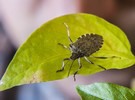 The amount of invasive brown marmorated stink bugs in 2022 tops anything seen in Oregon for at least five years and poses a serious threat to Oregon crops and garden plants, according to Oregon State University Extension Service’s orchard crop specialist.
The amount of invasive brown marmorated stink bugs in 2022 tops anything seen in Oregon for at least five years and poses a serious threat to Oregon crops and garden plants, according to Oregon State University Extension Service’s orchard crop specialist.
Nik Wiman, an associate professor in the College of Agricultural Sciences, said fruit and vegetable crops in the Willamette Valley have been affected.
“It’s unusual for brown marmorated stink bugs to feed on fruit and vegetable crops,” he said. “There has been a lot of damaging populations of BMSB in hazelnuts orchards. Growers use preventative measures so we’re surprised we’ve seen so many.”
It’s unclear why the population exploded this year, Wiman said. Like other insects, the population of the shield-shaped brown marmorated stink bug (BMSB) varies from year to year depending on climatic factors. The extremely wet spring most likely contributed to it, but the increase could also be attributed to a natural cycle.
Native to Asia, BMSB was introduced on the U.S. East Coast in the late 1990s – probably by ship – and has spread to almost every state in the country, including Oregon in 2004. The insect feeds on at least 170 plants, particularly vegetables, pears, apples and hazelnuts, but also ornamentals. Its name describes the odor they emit when they’re crushed.
Oregon’s hazelnut industry, valued at $132 million in 2020, is one of the state’s crops hardest hit by the invasive bug, according to the Oregon Department of Agriculture. The state’s problem echoes the situation in Turkey – the world’s leader in hazelnut production – as well as Italy and the country of Georgia, said Wiman, who researches alternative practices for controlling BMSB, including biological control, habitat manipulation, trap crops and barriers.
One promising biological approach is the samurai wasp (Trissolcus japonicus), an insect native to areas of Asia where it keeps the indigenous BMSB population under control. Scientists have discovered the wasp in the United States and Oregon, where it was initially distributed across the state by Wiman and a team of scientists at OSU and elsewhere. The Oregon Department of Agriculture is now leading the effort.
The parasitic wasp hunts for the egg masses of the stink bug and lays an egg inside each egg in the mass. The wasp develops inside the egg, effectively killing the stink bug, and then chews its way out. OSU Extension has a short publication on the wasp and its effect on the stink bug.
For more information:
Kym Pokorny
Tel: 541-737-3380
Email: kym.pokorny@oregonstate.edu
